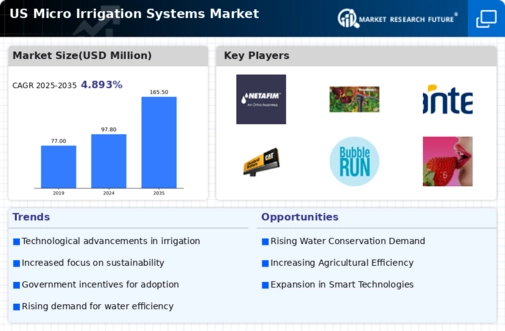Water Scarcity Concerns
The micro irrigation-systems market is experiencing heightened demand due to increasing concerns over water scarcity in the United States. As drought conditions become more prevalent, farmers are seeking efficient irrigation solutions to optimize water usage. Micro irrigation systems, which deliver water directly to the plant roots, can reduce water consumption by up to 50%. This efficiency not only conserves water but also enhances crop yields, making it an attractive option for farmers. The U.S. government has also initiated programs to promote water conservation practices, further driving the adoption of micro irrigation systems. As a result, the market is projected to grow significantly, with estimates suggesting a compound annual growth rate (CAGR) of around 12% over the next five years.
Growing Organic Farming Practices
The micro irrigation-systems market is positively impacted by the increasing trend towards organic farming in the United States. Organic farmers often require efficient irrigation solutions that align with their sustainable practices. Micro irrigation systems, which minimize water usage and reduce runoff, are particularly well-suited for organic farming. As consumer demand for organic produce continues to rise, farmers are adopting these systems to enhance their crop quality while adhering to organic standards. The organic food market in the U.S. is projected to reach $70 billion by 2027, which could drive further investment in micro irrigation technologies. This alignment between organic farming and micro irrigation systems suggests a promising growth trajectory for the market.
Rising Labor Costs in Agriculture
The micro irrigation-systems market is also influenced by the rising labor costs associated with traditional farming practices. As labor expenses increase, farmers are seeking ways to reduce reliance on manual labor for irrigation. Micro irrigation systems offer a solution by automating the watering process, thereby decreasing the need for labor-intensive irrigation methods. This shift not only helps in managing costs but also improves operational efficiency. With labor costs projected to rise by 5% annually, the adoption of micro irrigation systems is likely to accelerate as farmers look for cost-effective alternatives. Consequently, the market may witness a surge in demand, potentially leading to a market valuation of over $2 billion by 2028.
Government Incentives and Subsidies
The micro irrigation-systems market is bolstered by various government incentives and subsidies aimed at promoting water-efficient technologies. Federal and state programs provide financial assistance to farmers who invest in micro irrigation systems, making them more accessible. For instance, the USDA offers cost-sharing programs that can cover up to 50% of the installation costs. This financial support encourages farmers to transition from traditional irrigation methods to more efficient systems. As a result, the market is likely to see an increase in adoption rates, with projections indicating that the value of the micro irrigation systems market could reach $1.5 billion by 2027. Such initiatives not only enhance agricultural productivity but also contribute to sustainable water management practices.
Technological Advancements in Irrigation
The micro irrigation-systems market is significantly influenced by ongoing technological advancements that enhance system efficiency and usability. Innovations such as automated controllers, soil moisture sensors, and mobile applications allow farmers to monitor and manage irrigation more effectively. These technologies enable precise water application, reducing waste and improving crop health. The integration of data analytics into irrigation practices is also gaining traction, providing farmers with insights that can lead to better decision-making. As these technologies become more affordable and user-friendly, their adoption is expected to rise, potentially increasing the market size by 15% over the next few years. This trend indicates a shift towards more data-driven agricultural practices within the micro irrigation-systems market.




















Leave a Comment